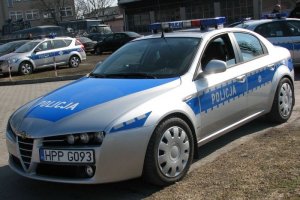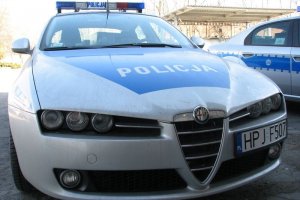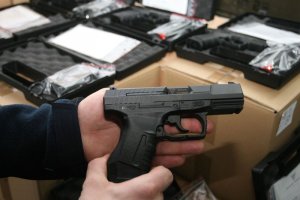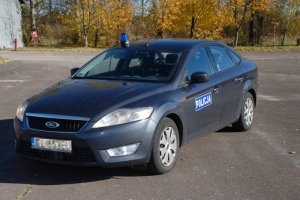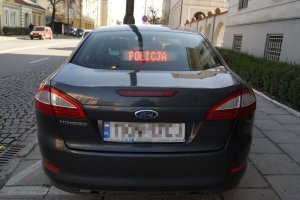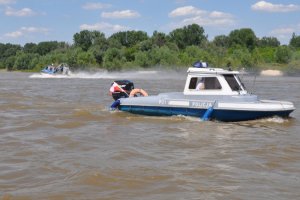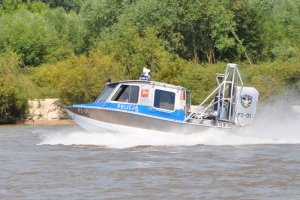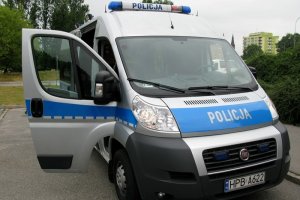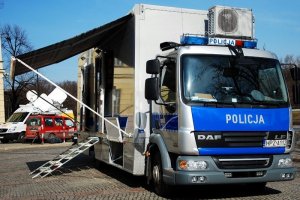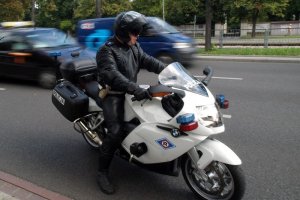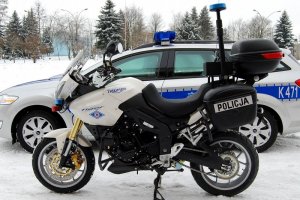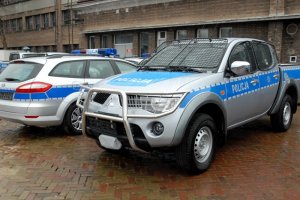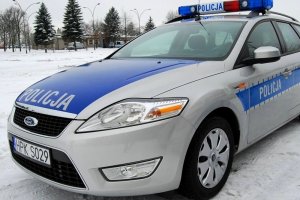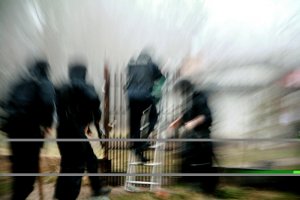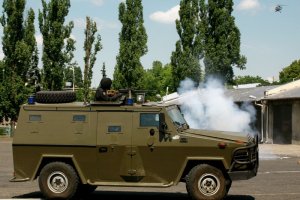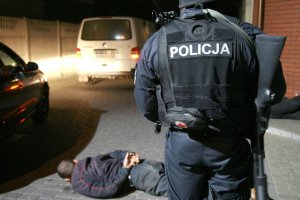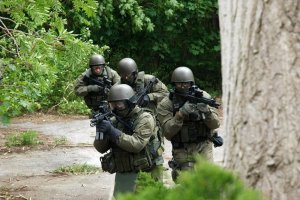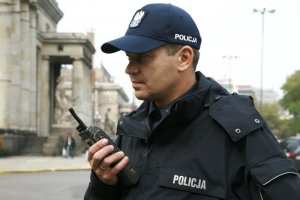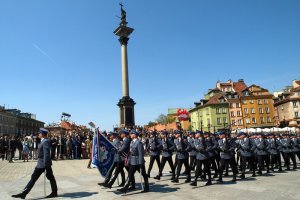Police in the Third Republic of Poland (1990–2010)
Źródło: "Polska Policja" - Wydanie II uzupełnione; Wyd. Wyższej Szkoły Policji w Szczytnie
In Poland of the 80s the resistance against legally binding regulations was developing and the economic situation of the country was worsening. These made the political authorities to look for solutions broadening social basis for having the power. In order to reach this aim, in 1989 the round-table talks were arranged, at which representatives of the government authorities and organisations sat, on the other hand these were representatives of the opposition acting as observers as well as having great respect clergymen of the Roman Catholic Church. The agreement that was made on 5 April contained quite limited changes, mainly it was democratisation of the political system. Partly, free elections that were held on 4 June 1989 showed however, that the camp which had been in power for 1944 had a very limited support. As a result, the recent opposition took over and the reforms went beyond the formerly made establishments to a great extent. In fact, they made a political transformation which affected the economic and social sector as well. The modifications caused changes in the internal affairs department inevitable, because socially it was thought to be the reality to be gone.
Parliamentary works, the result of which a new structure of a police apparatus having the standards of a democratic country was to be, were officially started pretty fast, thus in January 1990. The way of proceeding submitted projects of acts was also a very efficient one. Consequently, on 6 April 1990 the Seym passed new legal regulations which were called a set of police acts. In it there were 3 acts regulating organisation and activities of a minister of internal affairs’ post and two formations – the Office of State Protection (Urząd Ochrony Państwa) and the Police, which were subordinate to the former. Several months later, on 12 October 1990, the Seym accepted the act on the Border Guards (Straż Graniczna), which finished the basic process of organisational restructuring of the internal affairs department in terms of legislation. The new legislation was not given to the fourth large formation which was subordinate to the minister of internal affairs, that is the Vistula Military Units (Nadwiślańskie Jednostki Wojskowe). This fact was a result of divergent concepts concerning the future of this organisation, on the basis of which the contemporary president Lech Wałęsa wanted to create the Polish National Guard. Finally, none of the projects was accepted and the existence of the Vistula Military Units of the Ministry of Internal Affairs came to an end after a long period of ‘death throes’.
A set of police acts came into force on 10 May 1990 - the day of their publishing. Simultaneously, the internal affairs department identified as the previous political regime was abolished, and instead there was a new central body of the executive branch using the same name, but built to serve the needs of a democratic country. According to the statutory instructions, a minister of internal affairs became: “…the principal office of the state administration carrying out the country’s policy in the area of protecting the state security and the public order as well as the protection against illegal attempts on human life and health, cultural achievements, social properties and on particular citizens…” 1.
One of the main developments of the new laws, promoted especially by police officers, was organisational and functional separation of maintenance bodies from the security apparatus. When working conceptually, an idea of excluding the security system from the minister of internal affairs’ competences appeared. Finally, the idea proved to be premature then, because it was finalised as early as on 1 October, 1966, when the State Protection Office was excluded from the structures of the Ministry of Internal Affairs and it became directly responsible to the Prime Minister. Of an innovative nature, compared to the previous solutions, was restoring a fundamental principle of its interwar predecessor, that is political neutrality of police formations as well as of individual officers. It meant that police officers could not be members of any political party. At the very beginning, the ban was questioned, however after some time, it became accepted by all police officers. The ban followed the then applicable law, which was decided by the Constitutional Tribunal of 10 April, 2002.
Basic responsibilities of the police were defined in article 1 of the act in seven points. The key responsibility was protection of citizens’ human life and health as well as protection of property against unlawful attacks which cause damage to the property. All in all, the specified responsibilities were very similar to those attributed to the Citizens’ Militia (Milicja Obywatelska). The number of them was even smaller because the law of 1990 specified 7, while the decree of 1955 – as many as 13. The verbal similarity of written records resulted from a kind of imperfection of a written word which could not reflect precisely the spirit or philosophy of the operation of police units, social groups or other communities, which was supposed to make the militia different from police. Structured in socially unacceptable authorities, MO performed their tasks somehow in confrontation with the public, or at least some part of the public. The police were supposed to carry out similar tasks, expressed in similar words, in cooperation with the public, which was a consequence of a democratic order established after 1989.
Detailed solutions concerning the organisation and responsibilities of the police, included in the Police Act of 6 April 1990 and resulting from the above listed general assumptions, were the outcome of numerous concepts proposed during legislative works. The effect of them was, among others, keeping the centralised police structure, disapproved of by some groups, together with the establishment of local police, whose principles of cooperation with local authorities were slightly different from those of the remaining kinds of the police.
From a constructive point of view, the police act consisted of two parts. The first part included regulations concerning the organisation and operation of the police as a part of public administration performing the state tasks in protection of public order and safety. The second part constituted so-called police practice, i.e. regulations referring to a status of a police officer.
Principles of police organisation as laid down in part I of the act introduced the division into the so-called branches and regulated the police system from the territorial perspective. As for the latter one, at the very top of the police hierarchy was the national police chief, who was referred to in the act as the central body of the state administration competent for public order and safety protection. Among the local police authorities there were: regional police chiefs, district police chiefs and chiefs of police stations. Such a status was not given, however, to chiefs of special police stations and heads of local police posts.
For police operational activity of key importance were regulations set forth in chapter 3, under which the police had the right to conduct covert activities, criminal investigations, administrative and public-order activities, as well as others ordered by the court, prosecutor and central and local administration authorities. These powers could be executed by police officers of all branches except local police, who could perform only administrative and public-order activities. Another restriction on police powers, which reflected the spirit of the times, was a stipulation that police officers, when exercising their duties, were obliged to respect citizens’ dignity and protect and respect their human rights. This general premise was expanded with legal grounds for correspondence control and the use of so-called technical surveillance measures. Decisions authorising the use of such measures could only be taken by the minister of internal affairs, who additionally had to get permission from the attorney general. Another condition was that the tools in question could only be used to prevent or detect life-threatening crimes and those prosecuted under international agreements or partnerships. At the same time, the legislator explicitly stated the purpose for which so obtained information could be used, forbidding it to be passed on to any other subjects than judicial authorities and prosecutors, and to be used for purposes other than criminal prosecution.
From the viewpoint of police professional duties, such a strict legislator’s interpretation of one of the basic instruments available to the police in their fight against the underworld was not a very advantageous solution. It must be remembered, however, that this approach was in a way a consequence of such measures being abused in rather recent past. In addition, one could hardly expect that in the time of changes oriented at moral restoration there would be excessive tolerance towards controversial, if not reprehensible, methods of operation.
Another reaction to the previous abuse of power was also a demand for effective control over the police. The control was to be ensured by a social body, and yet despite its popularity the idea was difficult to be defined in legal terms. Moreover, community control of the police faced similar criticism as any other unofficial control bodies, e.g. lack of professionalism, limited time availability and others. In case of the police, this kind of control is further hindered by official secrets or confidential nature of police work, which when revealed would entail coming into the possession of restricted information about police officers’ covert activities or their secret collaborators. Thus, such suggestions were rejected just like other extreme ideas of the police being brought under the president’s control. Instead, a rather traditional solution was adopted whereby police chiefs were obliged to submit periodic reports on their activity and to inform relevant central and local authorities about planned public-order and safety operations. Additionally, as regards matters connected with internal organisation and performance of police duties, central and local authorities could require police authorities to provide explanations and restore public order. Another form of control was also a requirement for provincial governors or a competent local government body to give their opinion on local police chiefs. Subject to the control by local authorities were first of all local police whose posts could be established only on the application of a relevant local authority agency.
The entry into force of the package of regulations was an essential condition for starting the process of building new structures. First basic decisions regarding personnel were made on May 10, 1990. On that day, the Prime Minister appointed Krzysztof Kozłowski as the chief of the Office of State Protection, and Andrzej Milczanowski as his deputy. At the same time, in view of the fact that the Citizens’ Militia had been disbanded, he dismissed general Zenon Trzciński from the post of the Commander-in-Chief. Col. Leszek Lamparski was appointed the National Police Chief, while Col. Bogusław Strzelecki and Col. Janusz Wydra became his deputies. On the next day, the Trade Union of Police Officers was registered with the Regional Court in Warsaw, thus bringing to an end nearly ten-year-long efforts of police officers to form their own trade union.
A task of prime importance for the first police top executives was to organize personnel matters and to create an organizational structure that would be capable of operating successfully because, trivially speaking, the criminal world showed no understanding or consideration of internal problems of law enforcement agencies, and was becoming more and more active. These basic issues were addressed in June 1990, when new police chiefs were appointed in all 49 regions. Their appointment marked a real generation change in public order services, since for as many as 40 of them it was to be their first top managerial post. Only two of the former chiefs of the WUSW kept their posts at regional police headquarters, while the reminding seven had either been or had been acting as deputy chiefs of the WUSW. The changes that took place within the whole police service were of no lesser importance. Admittedly, militia officers did not have to go through the vetting process, but by the time a staff review was conducted in July 1990, 3027 former militia officers had been dismissed. This number included 17 officers who left at their own request, 220 of them were dismissed for retirement, while 2790 were dismissed based on Article 41 (2) of the Police Act, which reads that a police officer may be dismissed from the service when an important service interest requires so. In the months that followed, the number of those leaving the force did not decrease, which was due to parliamentary debates over a new retirement bill that was to be less favourable for uniformed services. As a result, according to 1993 records, about 30,000 new recruits joined the police force, all of whom required at least basic training. That task was entrusted to the reformed police education system. The leading role was given to the Higher Police School in Szczytno, which was established by the ordinance of the Council of Ministers of September 10, 1990. The other schools, also created in the second half of the year 1990, were the Police Training Centre in Legionowo, the Police School in Słupsk, the Police School in Piła, and local police training centres. In 1999, the network of police schools was expanded by setting up the Police School in Katowice.
First organisational structures of the Police force were created on June 15, 1990, when at the National Police Headquarters, by force of Directive No.5, colonel L. Lamparski created the following units: Chief Commander’s Cabinet, Criminal Intelligence Bureau, Criminal Investigation Bureau, Forensic Bureau, Covert Techniques Bureau, Crime Prevention Bureau, Road Traffic Bureau, Communications Bureau, Bureau of Information Technology, Personnel and Training Bureau, Bureau of Provisions, Bureau of Finances. The most controversy and debate was aroused by the fact that the new structure did not provide for the economic crime unit, which was dissolved on January 18, 1990, so still in the days of militia. Cynics, who also adhered to a conspiracy theory, explained this with deliberate negligence aimed at facilitating new capitalists to earn the proverbial first million dollars. However, idealists took a stand that the reason behind the decision was the belief that eliminating state – and in common feeling nobody’s – ownership will make this department unnecessary, since each private owner would look after their own property. Regardless of the motivation, the decision proved to be wrong. Thus, on June 13, 1991, the National Police Chief announced the recreation of the department for combating economic crime, and on July 10 he put this intention into practice by setting up the Department for Combating Serious Economic Fraud of the KGP.
The recreation of the department for combating economic crime initiated numerous organisational changes within the police, which, as a rule, involved the appointment of a new chief. This practice was initiated by chief superintendent L. Lamparski’s successor, superintendent Roman Hula, during whose term of office there were two departments at the KGP that were recognised as the leading ones, i.e. the Criminal Police Department, and the Prevention and Road Traffic Department. They were to be supported by seven bureaus. Obviously, this organisational concept was copied by regional units.
In practice, the ‘departmental’ organisational structure demonstrated neither any possible advantages nor disadvantages, as its promoter soon handed in his resignation, which was accepted on January 14, 1992, and his successor, superintendent Zenon Smolarek, implemented another reorganisation. Departments were no longer basic units, and this status was given back to bureaus again. Initially, there were 14 of them, and their capacities and names coincided with the solutions that had been introduced by chief superintendent L. Lamparski; however, the National Bureau of Interpol and the Central Forensic Laboratory gained the status of independent units. On January 1, 1994, this structure was complemented by the Bureau for Combating Organized Crime. This reorganisation was justified by the need to eliminate indirect units at the level of the KGP, and departments were considered as such, as well as by the need to create a clear organisational model that would enhance a more efficient management of the police service. At the same time, there was created a team called ‘Police 2000’, whose task was to work out the future model of the service. The team’s concepts have never been put into practice, since the contemporary needs necessitated subsequent changes. One of the more important changes took place in 1997, and it was the formation of a branch aimed at combating drug-related crime, which led to the establishment of Central Investigation Bureau (Centralne Biuro Sledcze – CBS). Formally, the unit was created on January 15, 2000, from the merger of the Bureau for Combating Organised Crime and the Anti-Drugs Bureau. The decision proved to be a good one, as the CBS not only has been very effective in carrying out its mission, i.e. combating organised crime, but has become a flagship agency of the whole police service.
Another type of changes taking place within the police organisation was connected with the implementation of reforms introducing new territorial and administrative division of the country, which restored the three-level division, i.e. commune, county and region. On January 1, 1999, in place of former regional and district police headquarters there was created a new network of police units headed by the National Police Headquarters. Within the new organisational structure, the National Police Headquarters is superior to 16 regional headquarters and the Warsaw Metropolitan Police Headquarters, which is a city headquarters whose status is equal to the status of regional headquarters. Below in the hierarchy, there are 329 county headquarters,
316 of which used to have the status of district police headquarters and 13 the status of police stations. At the bottom of the structure, there remained police stations in the number of 2072.
Apart from external factors, the effectiveness of a police force in carrying out their responsibilities depends on good cooperation with police forces of other countries. Therefore, the Polish police authorities put a lot of effort and commitment into rejoining Interpol – Poland left the organisation at the beginning of the 1950s. The effort was crowned with success when, at the Interpol General Assembly in Ottawa on September 27, 1990, the decision was taken to accept Poland into its membership. However, it involved the creation of adequate organisational units to cooperate with Interpol. At the beginning, this was the task of a division with the status of a department operating within the Criminal Recognition Bureau of the National Police Headquarters (KGP). On December 1, 1991, the division was transformed into the National Unit of Interpol of the Criminal Police Department of the KGP, and on August 1, 1992, it became an independent unit called the National Bureau of Interpol of the KGP. On May 1, 1998, on the basis of the Polish Interpol Bureau there was created the International Police Cooperation Bureau of the KGP, which, following the recommendations of the Council of the European Union, became a central unit charged with the responsibility for coordinating police cooperation with foreign partners. Broadening the scope of responsibilities by contacts with new partners was mainly caused by the creation of a police agency of the European Union, i.e. Europol.
Cooperation of the Polish police with the new agency was directly dependent on relations between Poland and the European Union. The good start was facilitated by the European Parliament resolution of 3 April 1998, which recommended that on the coming into force of the Europol Convention there should be initiated cooperation between the organisation and police forces of the EU accession countries. Not long after this, on May 28, 1998, in Brussels, there was adopted the Pre-Accession Pact on Organised Crime, the parties to which were the EU Member States on the one side, and Central and Eastern European candidate countries and Cyprus on the other. Almost at the same time, a Polish police officer was accredited with the Embassy of the Republic of Poland in the Hague, the Netherlands. His task was to support the Europol integration process, as well as to serve as liaison officer after the signing of the agreement on cooperation with Poland as the third country.
The latter condition was fulfilled on October 3, 2001, when of all the EU candidate countries Poland was the first to conclude a cooperation agreement with Europol on combating crime. It should be noted that the agreement did not introduce Poland into Europol, since art. 46 of the Europol Convention clearly indicated that membership in the organisation was open exclusively to the EU Member States. Poland met this fundamental requirement on May 1, 2004, and became a member of Europol on November 1, 2004, 90 days after the submission of the accession documents and the ratification of the Europol Convention and its amending protocols, all of which were published on July 12, 2004, and entered into force on July 27, 2004.
From the perspective of the Polish police, the joining of Europol by Poland on November 1, 2004, was an event of great importance, both as regards its symbolic aspect and merits. It was not only the fulfillment of natural aspirations, but also the proof of proper organisation of the police force and adequate standards of police training. Furthermore, it removed limitations connected with the status of associate member. Since November 1, Poland has been able to enjoy all the possibilities created by the Europol Convention, and especially access to the databases of Europol, as well as to the databases of other Member States.
Numerous organisational changes within the police force were dictated mainly by the necessity to adjust its structures to the dynamically changing reality, including the need to deal with the increase in crime. From this perspective, the Police Act of April 1990 soon proved to be too restrictive, which in later years brought about its many amendments. Of particular importance was the change introduced in July 1995, since it provided the police with new methods of working which, although considered morally dubious, were on the other hand essential. It was then that the police were given the right to use such instruments as controlled purchase, controlled bribery and controlled delivery. In addition, there was extended the list of instances allowing the use of arms, the tapping of telephones, and the surveillance of correspondence. The police were given a statutory right to lift, collect and use for detection and identification purposes fingerprints, photographs and other data of persons suspected of committing premeditated crime or crime punishable on indictment, as well as of unidentified persons, and of those trying to conceal their identities. As regards more general dispositions, the amendment of 1995 extended the list of police tasks by including in it the protection of public peace “in means of public transportation” and “on public waters”. As for the part on the types of police, the former regulations were replaced with new, more functional ones which introduced four types of services, namely, criminal police, crime prevention police, police support service, and a service not known before, i.e. court police. It was also clearly specified that the police educational and training institutions, as well as the riot police units and anti-terrorist units were parts of the police force, while the local police was disbanded.
It can be assumed that the year 1995 brought a significant change in the police strategy for combating crime. It was then that simple recipes for increasing the effectiveness of the police, such as not fully prepared reorganisation, or demanding the employment of more police officers as the condition for success, were abandoned. Instead, there was a shift towards long-term activities, which do not usually bring immediate results but are effective in the long term.
After 20 years have passed, the Act on Police of 6 April 1990, as well as the organisation that was created on its basis have little in common with their prototypes. The Act has been amended so many times that it is not much of an exaggeration to say that the only thing which has not been changed is the title. This has been followed by frequent changes in police personnel, which were not only for biological reasons. And the change expected in the nearest future is that of the uniform, which is probably the last remaining element inherited by the police organisation from its predecessor, i.e. from the citizens’ militia. Thus, as regards the material aspect, nearly everything changed; however, what remained unchanged was the idea behind works on the act, which aimed at creating an organisation that would be non-political, unbiased, effective, public-friendly, acting on behalf and in symbiosis with it. Today not all of the values and goals have been fully achieved. In the third decade of the service, the police and its officers should strive to eliminate the shortcomings.
Bibliography
Bereś, W., Brunetko, K. Gliniarz z „Tygodnika”. Rozmowa z byłym ministrem spraw wewnętrznych K. Kozłowskim. Warszawa 1991.
Chmielewski, R., Dzieliński, W., Majer, P. Policja 1990–1999 [in:] Przegląd Policyjny 1999, issue 1(53) – 2 (54).
Hołyst, B. Międzynarodowa Organizacja Policji Kryminalnej [in:] Problemy Kryminalistyki 1990, issue
189–190.
Gawłowicz, I., Wasilewska, M. A. Międzynarodowa współpraca w walce z przestępczością (międzynarodowe trybunały karne, Interpol). Szczecin 2004.
Majer, P. Ustawy polskiej policji (1791–1990). Źródła z komentarzem. Szczytno 2007.
Ostant, W. Polska Policja jako partner w systemie Europejskiego Biura Policji — Europol [in:] Szymaniak, A., Ciepiela. W. (eds.). Policja w Polsce. Stan obecny i perspektywy. Poznań 2007.
Pieprzny, S. Policja. Organizacja i funkcjonowanie. Kraków 2003.
Majer, P., Misiuk, A. (eds.). 15 lat polskiej Policji (1990–2005). Szczytno 2005.



